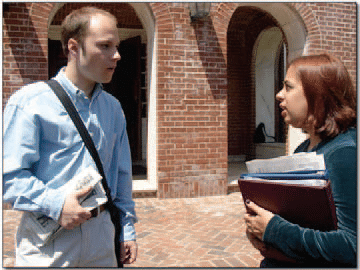Speaking SectionのQuestion 2で高得点をとるコツはあるの?どんな対策が有効かなあ?
以下は、このような疑問への回答です。
Speaking Section Question 2は質問の形式が決まっています。この形式を理解して、攻略方法を学ぶことが効果的ですので、Question 2 の出題形式から見ていきましょう。
でも、その前に、少し注意を喚起したいことがあります。攻略法やテンプレートを提供しているインターネットのサイトがたくさんありますが、そういったサイトには不正確な情報や、必ずしも有益ではないテンプレートが含まれている場合があるということです。また、こういったテンプレートなどの問題は、Speaking Sectionに限らず、Writing Sectionにも共通することです。念頭に置いておきましょう。
Question 2 の出題形式
最初に、 Question 2 の全体像を把握しましょう。 Question 2 は、読んで(ア)、聴いて(イ)、話す(ウ)という構成です。もう少し具体的に言うと、次の通りです。
(ア)まず、短い reading passageを読みます。これは、大学が何らかの計画を学生に知らせるための掲示物や学内新聞の記事のようなものです。大学の計画はどのようなものかと言うと、学費を上げる、選択科目のいくつかを廃止する、新たなキャンパスを開設する、など学生に影響を及ぼす計画です。このreading passageを読むために与えられる時間は、45秒か、あるいは50秒と指定されます(当該 reading の長さ次第です)。
(イ)次に、この reading の内容(大学の計画など)について2人の学生(男女)が話しているのを聴きます。長さは、60~80秒程度の会話です。どちらかの学生が、明瞭な意見とその理由を話します。
(ウ)そして、 the reading passageと2人の学生の会話に含まれていた内容をもとにして、質問に答えるレスポンスを話すということです。例えば、「女子学生は大学側の計画に関して意見を述べているが、彼女はどういう意見を述べているのか、そしてその意見の理由は何か、説明しなさい」というような問題が出ます。これに対応するレスポンスをマイクロフォンに向かって話すのです。話す内容を考える時間は30秒、話す時間は60秒間です。

この(ア)、(イ)、(ウ)を例題を使って具体的に詳しく見ていきましょう。
例題1
(ア)Reading Passage を読む
最初に reading passageの説明が聞こえます。どういう内容の reading passageなのか聞きとりましょう。例えば、次のような説明が読み上げられます。この記事では、ETSが以前ウエブサイトで公開していた Quick Prep, vol. 1 を例題として使います。この練習問題では、読む時間として45秒与えられていますね。
The university is making a change in the courses it will offer. Read the article from the university newspaper about the change. Give yourself 45 seconds to read the article.
そして、画面に the reading passage が表示されます。画面の右上の方に、残り時間を示す小さなタイマーがあり、それが動き出します。The reading passageを読むときは、まずタイトルを見てから本文を読みましょう。大学側が発表した計画がどの様な計画なのか把握しましょう。主なポイントのメモを取るのも賢明ですね。なぜなら、この reading passageは読む時間が過ぎると画面から消えてしまい、再び読むことができないからです。
Sculpture Courses to Be Discontinued
University administrators announced yesterday that the sculpture program, a division of the art department, will be eliminated. “The main reason is a lack of student interest,” reported one administrator. “Although the number of art students has increased, fewer and fewer art majors are taking sculpture classes.” Furthermore, the department’s only sculpture professor is retiring this year. “Given the art department’s limited budget,” the administrator explained, “it just doesn’t make sense to hire a new full-time professor to teach sculpture for only a handful of students.”
(イ)会話を聴く
次に、2人の学生(男子学生と女子学生)が会話している様子を示す画像が画面に表れます。

(Quick Prep, vol. 1)
そして、ナレーターが次のようにしゃべります。
Now listen to two students discussing the article.
すぐに、2人の学生の会話がヘッドホンから聞こえてきます。
実際の TOEFL iBT ではもちろんこの会話は、聞くだけであり、スクリプトは表示されません。しかし、ここでは、答え方を説明するためにスクリプトを使用します(Quick Prep, vol. 1)。
Male student: Everything alright?
Female student: Yeah, I’m just upset about that article I showed you this morning …
Male student: Why, what’s the big deal?
Female student: Well, as an art major, I think it’s a big loss for the department. The university’s got it all wrong.
Male student: What do you mean?
Female student: Well, the low enrollment isn’t because art majors don’t want to take these classes. Problem is, who has time to take them when there are so many other requirements?
Male student: I don’t understand.
Female student: See, the classes they’re eliminating are all optional. The required courses are mostly painting and drawing, and they take up all our time. What we really need are different requirements — then art majors could take a better variety of classes … all the things we’re interested in.
Male student: That makes sense. But, the thing about the professor …
Female student: Well, that’s true. But still, they’re being drastic. If money’s the problem, they could hire a part-time professor! Or, most of the professors in the department have secondary fields …
Male student: Really?
Female student: Yeah! At least a few painting teachers are also great sculptors. I’m sure one of them could teach a class.
この会話を聴くときは、意見を述べている学生が大学の計画に賛成なのか反対なのか、その理由(理由は常に2つ)は何と何なのか聞き取ります。できれば、二つの理由を素早くメモしましょう。しかし、メモを取りながら聴くのが難しければ、聴き取りに集中しましょう。
(ウ)レスポンスを話す
実際の TOEFL iBT では、会話が終わるとすぐに、次のような設問が聞こえてきます。設問の読み上げが始まると同時に、この設問が画面に表示されます。
The woman expresses her opinion of the university’s plan. State her opinion and explain the reasons she gives for holding that opinion.
これに対応するレスポンス(答え)を30秒で考えて、60秒の間に、マイクロフォンに向かってそれをしゃべります。
画面に、この制限時間が表示されます。
Preparation Time: 30 seconds
Record Time: 60 seconds
レスポンスに含めるべきポイントは次の3点です。
- 学生(the man あるいは the woman)がreading passageに書かれている計画に対してagreeかdisagreeなのか
- その理由は何と何か(必ず2つあります)
- 学生の意見が、reading passageに書かれている計画にどう関連しているのか
それでは、レスポンスの一例を見てください。まず、the woman は reading passage に書かれている計画に対してdisagreeであるとはっきりと言います。たとえば、 下のようなことをしゃべります。
The woman disagrees with the plan to discontinue the sculpture courses and states that it’s a huge loss for the department.
次に、彼女が disagree する理由の1つ目を説明しましょう。たとえば、次のように、話すことができます。
The woman says that the reason for the low enrollment is that students majoring in art have so many requirements, such as painting and drawing, that they don’t have time to take the sculpture classes, which are optional. She believes that the low enrollment is not due to a lack of student interest as the university claims.
その次に、彼女が disagree する2つ目の理由を説明しましょう。たとえば、次のように、話せばいいでしょう。
The woman also points out that the university could hire a part-time professor instead of a full-time professor and that some art professors have secondary fields that would qualify them to teach the sculpture classes. She argues that not being able to afford a full-time professor is not a valid reason for closing the sculpture courses as the university claims.
答え方の基本形
1つ注意したいのは、学生の理由を説明するときに大学側の発表の根拠に関連付けをしないといけないからといって、大学の計画を詳しく述べる必要はありません。あくまでも、学生の意見・理由を話すことが重要です。大学の計画については最低限の情報だけを含めましょう。コツとしては、レスポンスの冒頭で、「The (wo)man (dis)agrees with the plan to」というようなフレーズを使うことです。
上で示した答え方の中で赤い下線を引いた部分は、Question 2 でどのようなテーマが扱われたとしても使えるフレーズですので、下に答え方の基本形としてまとめます。これを頭に入れて試験に望んでください。そうすれば、実際の TOEFL iBTを受けている最中に、どんなフレーズ・表現を使おうか、どんな構造のレスポンスにしようか、などと迷う時間を減らせます。
答え方の基本形
• The (wo)man (dis)agrees with the plan to ….
• The (wo)man says that….
• (S)he believes that ….
• The (wo)man also points out that….
• (S)he argues that ….
文字が赤色の表現は「~と言う」「~と主張する」「~と考える」といった意味の単語・表現で、これらは、類義表現・同意表現です。同じ単語ばかりを使うと、表現力・語彙力が乏しいと採点者に思われかねません。さまざまな表現を使いましょう。Question 2 のレスポンスで使える、「~と言う」「~と主張する」「~と考える」といった意味の表現を下にまとめます。
例題2
それでは、音声も使って例題をやってみましょう。ETSが以前配布していたQuick Prep, vol. 3という教材に含まれている問題を使います。
最初に reading passageの説明をナレーターが読み上げます。音声ファイル を聞きましょう。
次に、 reading passageを読みます。この例題では、読む時間として50秒与えられています。
Music Coming to Cafeterias
Mary Dixon, Director of the Student Life Committee, announced yesterday that beginning next semester, university cafeterias will broadcast classical music during mealtimes. “Music will foster a more relaxed atmosphere,” said Dixon. “Students’ lives are hectic, and mealtimes provide important opportunities to take a break and catch up with friends before moving on to the next class or assignment.” Added Dixon, “We’re also hoping that, if we provide the music, students will unplug their personal music devices—their Walkmans™ and MP3 players or whatever—and will spend more time talking to each other. When students have their headphones on, they’re not connecting with each other.”
50秒経過した後すぐに、2人の男女学生の会話が始まります。音声ファイルを聞いてください。2人の学生の会話の後すぐに、設問が読み上げられます。
実際の TOEFL iBT では、設問の読み上げが始まると同時に、画面にもこの設問が表示されます。
The man expresses his opinion of the university’s plan. State his opinion and explain the reasons he gives for holding that opinion.
持ち時間も表示されます。
Preparation Time: 30 seconds
Response Time: 60 seconds
上で見た「レスポンスに含めるべきポイント」を再確認してから、レスポンスを30秒考えましょう。
そして、レスポンスを60秒以内で話してみましょう。
いかがでしたでしょうか。
レスポンスの一例
まず、the man は reading passage に書かれている計画に対して agree か disagree なのかをはっきりと言います。たとえば、 下のようなことをしゃべります。
The man disagrees with the plan to play classical music over the loudspeakers in the cafeterias during mealtimes
次に、彼が disagree する理由の1つ目を話します。
The man argues that students actually want to study during meals, not relax. He believes that the music will not help students relax as the university claims and that students would probably find the music distracting.
その次に、彼が disagree する2つ目の理由を説明しましょう。たとえば、次のように、しゃべりましょう。
The man also points out that most students don’t like classical music anyway. He says that they will keep listening to their own personal music devices, rather than unplug their music devices or spend more time talking to each other as the university hopes.
以上です。
それでは、スクリプトを下に掲載します(Quick Prep, vol. 3)。
まず、reading passage に関する説明です。
Narrator: City University plans to begin playing music over loudspeakers in the campus cafeterias. You will have 50 seconds to read an article from the campus newspaper about the plan. Begin reading now.
そして、会話の部分です。
Narrator: Now listen to two students discussing the university’s plan.
Male Student: Did you read this article? Are they serious?
Female Student: Yeah, I think so. Why?
Male Student: Well, first of all, a lot of kids aren’t looking for a relaxing break at lunchtime. They like to study while they eat, especially if they have exams coming up, or some assignment they have to get done.
Female Student: Yeah, that’s true.
Male Student: And now they won’t be able to concentrate. This is gonna be very distracting.
Female Student: Mmm. OK, yeah, I see your point.
Male Student: And second, most students don’t like classical music.
Female Student: It’s certainly not what I listen to.
Male Student: So are people going to stop listening to their own music?
Female Student: No.
Male Student: I think people are going to be even more likely to bring their mp3 player, you know, to play their own music and block out the classical stuff.
Female Student: Yeah, that makes sense.
Narrator: The man expresses his opinion of the university’s plan. State his opinion and explain the reasons he gives for holding that opinion.
以上が、TOEFL iBT Speaking Section: Question 2 得点アップの方法です。
* * * * * *
★ ところで、TOEFL 必須語彙のおすすめ教材をこちらで紹介しています。ご覧ください。





